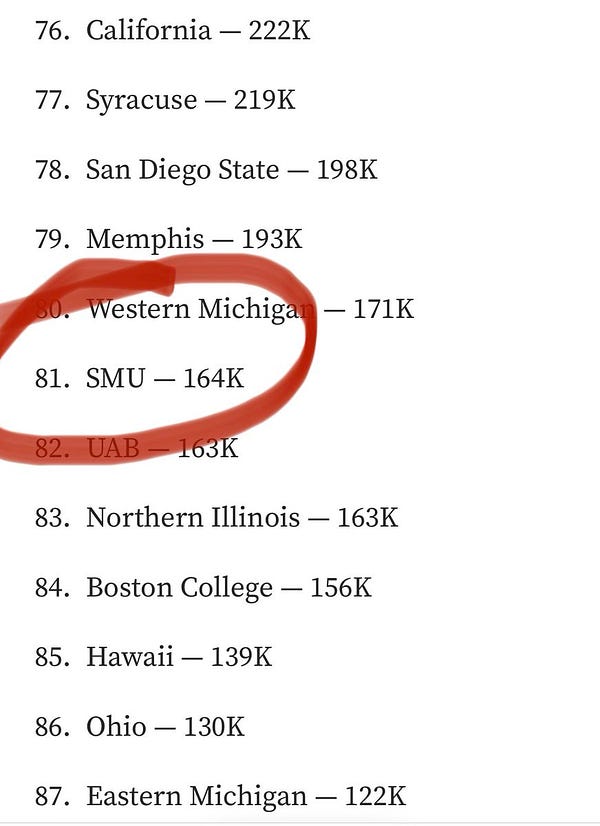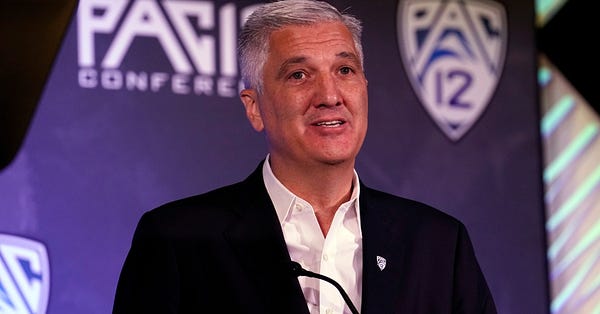Will the Pac-12 add San Diego State and SMU, and will expansion save the Pac-12?
The Pac-12 needs to get a bigger media rights deal that includes streaming and TV partners, and expansion is necessary.
The Pac-12 is looking to expand again. Newest targets: The San Diego State Aztecs and the SMU Mustangs. Oh how things have changed.

San Diego State’s inclusion into a new Pac-12 makes plenty of sense. The conference needs some presence in Southern California to recoup the losses of the LA teams, and the Aztecs are the largest program left available. The Aztecs do bring in the San Diego market which ranks top 30 overall. They field competitive football teams that regularly beat Pac-12 teams. They have a men’s basketball team that regularly makes the NCAA Tournament.
SMU being added to the mix is a bit surprising, but from a TV perspective would be critical for adding the state of Texas into their footprint. Pac-12 commissioner George Kliavkoff was spotted at an SMU basketball game this week.


SMU also is situated in Dallas, although you’d be hard justifying that this program holds any real sway in the city compared to the other major programs in the state.



Another crucial qualification is both San Diego State and SMU are R2 research institutions which offer doctorates, and it sounds as if San Diego State is closing in on becoming an R1 this decade. It’d be a small step down for the Pac-12’s academic prestige, as all 10 members of the Pac-12 are currently R1 universities.
There are actual R1 research institutions within the geographic footprint of the conference like UNLV, Nevada and Colorado State, but they are in much smaller media markets. UNLV would be the most attractive of the bunch because of the city they’re in, but their lack of commitment in athletics might be less attractive.
R2 universities close by include Fresno State and Boise State. Central California does have a fairly large population that has some loyalty to the Bulldogs. But there does appear to be not great feelings between Fresno and Cal/Stanford, so that might be a tough sell.
You’d have to imagine the Big 12 would look hard at several Mountain West schools in the next round of expansion too to continue growing their footprint from coast to coast. But they probably have bigger targets at the moment.
75% of Pac-12 members need to ratify expansion—it seems conference members have learned a bit from their previous expansion efforts, where unanimity was required.


The biggest reason for expansion is the TV media deal. All reports indicate that the Pac-12 is not even close to hitting the numbers of the latest Big 12 TV deal, which was their unofficial goal.


Due to the loss of UCLA and USC to the Big Ten, the conference has lost over a third of their bargaining power, and it’s bled on over into TV negotiations. The rumored deals with Amazon appear to have not returned the numbers necessary for the streaming giant to take on the Pac-12 inventory. Which means the Pac-12 needs some TV partners, but ESPN has gobbled up most of the SEC and ACC inventory, the Big 12 holds its usual Fox and ESPN split, while FOX/CBS/NBC have gone all in on the Big Ten. Who is left to bite?
In short, it’s hard to say if expansion will save the conference.
If the Pac-12 cannot hit their stated goals in TV rights negotiations, it’ll be hard to keep the conference together. The four corner schools (Arizona, ASU, Colorado, Utah) continue to be courted by the Big 12. Oregon and Washington were shut out of the Big Ten talks the first time around, but might be swayed to start talking to other conferences.
It’s hard to say what Cal and Stanford really want. Stanford does not need any TV rights deal to be successful thanks to their huge endowment. Cal definitely does as they continue to pay off debt service, although the potential Calimony assist from UCLA for their unilateral exit could help.
SMU and San Diego State will provide a few dozen more games and inventory that could boost TV rights a bit. But will that bump be enough? The Conference of Champions will only be consolidating their losses with expansion from the USC and UCLA exit. It cannot possibly offset it, meaning at most their next TV deal will hold their revenues steady rather than bolster them.
Oregon and Washington, the most valuable programs from a TV perspective, will likely keep looking. It’d be wise for Cal and Stanford (who are valuable for many other reasons besides revenue sports) to stay in constant conversation with the two programs in keeping their options open.
Even if expansion happens, the Pac-12 will likely have to make many more moves to ensure it stays a power player in the long-term future of college athletics.


George Kliavkoff certainly came on board at a tough time.
SMU would be weird from a tradition point of view. I'm all in on SDSU...Go Aztecs!